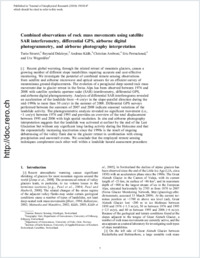Combined observations of rock mass movements using satellite SAR interferometry, differential GPS, airborne digital photogrammetry, and airborne photography interpretation
- Strozzi, Tazio Gamma Remote Sensing, Gümligen, Switzerland
- Delaloye, Reynald Geography Unit, Department of Geosciences, University of Fribourg, Fribourg, Switzerland
- Kääb, Andreas Department of Geosciences, University of Oslo, Norway
- Ambrosi, Christian Institute of Earth Sciences, University of Applied Sciences of Southern Switzerland, Canobbio, Switzerland
- Perruchoud, Eric Geography Unit, Department of Geosciences, University of Fribourg, Fribourg, Switzerland
- Wegmüller, Urs Gamma Remote Sensing, Gümligen, Switzerland
-
31.03.2010
Published in:
- Journal of Geophysical Research. - 2010, p. F01014
English
Recent global warming, through the related retreat of mountain glaciers, causes a growing number of different slope instabilities requiring accurate and cost-effective monitoring. We investigate the potential of combined remote sensing observations from satellite and airborne microwave and optical sensors for an efficient survey of mountainous ground displacements. The evolution of a paraglacial deep-seated rock mass movement due to glacier retreat in the Swiss Alps has been observed between 1976 and 2008 with satellite synthetic aperture radar (SAR) interferometry, differential GPS, and airborne digital photogrammetry. Analysis of differential SAR interferograms revealed an acceleration of the landslide from ∼4 cm/yr in the slope-parallel direction during the mid-1990s to more than 30 cm/yr in the summer of 2008. Differential GPS surveys performed between the summers of 2007 and 2008 indicate seasonal variations of the landslide activity. The photogrammetric analysis revealed no significant movement (i.e., <1 cm/yr) between 1976 and 1995 and provides an overview of the total displacement between 1995 and 2006 with high spatial resolution. In situ and airborne photography interpretation suggests that the landslide was activated at earliest by the end of the Last Glaciation but without any significant long-lasting activity during the Holocene and that the exponentially increasing reactivation since the 1990s is the result of ongoing debutressing of the valley flank due to the glacier retreat in combination with strong precipitation and snowmelt events. We conclude that the employed remote sensing techniques complement each other well within a landslide hazard assessment procedure.
- Faculty
- Faculté des sciences et de médecine
- Department
- Département de Géosciences
- Language
-
- English
- Classification
- Meteorology, climatology
- License
-
License undefined
- Identifiers
-
- RERO DOC 18066
- DOI 10.1029/2009JF001311
- Persistent URL
- https://folia.unifr.ch/unifr/documents/301566
Statistics
Document views: 128
File downloads:
- pdf: 326
